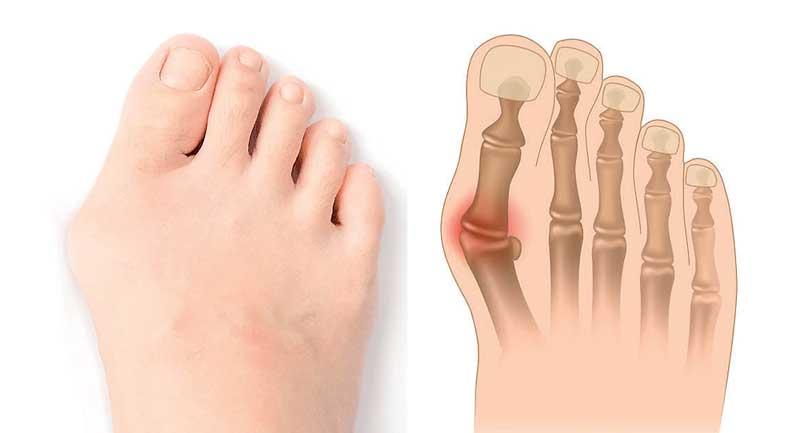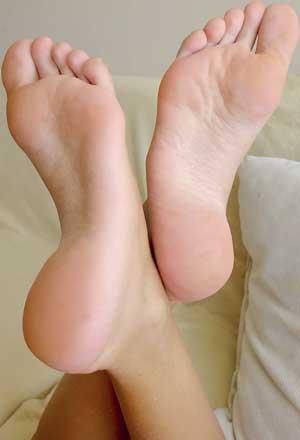06 Sep 2019 - {{hitsCtrl.values.hits}}

 Numerous arthritic conditions affect the foot, but this article will highlight some of the ailments that develop outside the joints. The foot is the terminal structure that bears you from the early age of ten months onwards. Tremendous weight and pressure go through these tiny feet exposing the bones to high risk of damage. Out of a variety of arthritis types we observe osteoarthritis and inflammatory arthritis causing significant damage to the foot. But other than for joints and bones many soft tissue structures help the feet to remain sturdy. Namely these are ligaments, muscles, tendons, fat pads and bursae. Any of these delicate parts can get damaged due to natural wear/ tear or sudden trauma. I will briefly explain conditions such as callosoties, bunions, flat feet, enthesitis, ingrown toe nails and fungal infections in the following paragraphs.
Numerous arthritic conditions affect the foot, but this article will highlight some of the ailments that develop outside the joints. The foot is the terminal structure that bears you from the early age of ten months onwards. Tremendous weight and pressure go through these tiny feet exposing the bones to high risk of damage. Out of a variety of arthritis types we observe osteoarthritis and inflammatory arthritis causing significant damage to the foot. But other than for joints and bones many soft tissue structures help the feet to remain sturdy. Namely these are ligaments, muscles, tendons, fat pads and bursae. Any of these delicate parts can get damaged due to natural wear/ tear or sudden trauma. I will briefly explain conditions such as callosoties, bunions, flat feet, enthesitis, ingrown toe nails and fungal infections in the following paragraphs.
What are callosoties
Callosoties are seen over high pressure areas of your feet. These are thickened parts of skin at the bottom of your feet that are troublesome because of pain. Some patients bear weight in an abnormal manner putting more pressure on certain areas causing that part of the foot to have thick skin. The thickened skin extends deeply and gives rise to pain. Treatment involves using corn plasters and sometimes simple surgery under local anaesthesia. To avoid such diseases we advise patients to use proper footwear; such as comfortable running shoes, trainers or tailor made insoles. These will offload that specific area of your foot and resolve the callosities.
Some are born with flat feet while others acquire this condition. All parts touch the ground and this is painful on the long run
On bunions
Do you have that big toe which bends to the outer side. With the base of the big toe jutting out like a hump. Well that’s a bunion and we term the deformity of the toe as hallux valgus. There are lots of reasons why people develop bunions and toe deformities. Arthritis and abnormal weight bearing through the toes might be some reasons. Again correction of bunions and angulated toes might require surgery. To prevent worsening tailor made insoles are used. Tight footwear is best avoided in patients with bunions.
What happens with flat feet?
Feet have three arches which levitate us above ground. These arches act like springs or shock absorbers. Not all parts of the bottom of your foot touch the ground. During walking, the heel strikes the ground first and then the weight moves through the outer aspect of the feet to end up at the toe. This is when you push off the body weight using your big toe. A flat foot is when someone has no arches over the bottom of his feet. Some are born with flat feet while others acquire this condition. All parts touch the ground and this is painful on the long run.
The arches act as springs/ coils. When the shock absorber property is lost, the entire body vibrates when one moves about. Specially designed insoles and proper footwear will work wonders for people with flat feet.
Enthesitis of the feet explained
Enthesitis is when a band like structure in the foot called a tendon or a ligament swells up close to a bone or a joint. The feet have two varieties of enthesitis which results in great deal of pain. These are plantar fasciitis and achilles tendinitis. Plantar fasciitis happens at the bottom of your foot where the ball of the heel strikes the ground. Achilles tendinitis is when the back of the foot / ankle swells up. The exact reason behind enthesitis is not known. Treatment involves physical manoeuvres like stretching, medication and proper comfortable footwear.

Painful ingrown toe nails
 Certain nails especially the big toe nail might dig into the skin especially if cut very short. The outer or inner aspect of the toe nail might grow slowly into the surrounding toe skin causing pain and sometimes infection. People who cut their toe nails in a semicircular fashion might experience this. To avoid such a situation you could cut the nail right across in a straight line. Ingrown toe nails require minor surgery.
Certain nails especially the big toe nail might dig into the skin especially if cut very short. The outer or inner aspect of the toe nail might grow slowly into the surrounding toe skin causing pain and sometimes infection. People who cut their toe nails in a semicircular fashion might experience this. To avoid such a situation you could cut the nail right across in a straight line. Ingrown toe nails require minor surgery.
Fungal infection of the toes
Damp and moist conditions favour fungal infections to settle in within the nail bed of toes.The result may damage the newly formed nails. Fungal infections are easily treatable with anti fungal ointments. I always emphasise the importance of taking great care of ones feet. Feet suspend us for an entire lifespan. Keeping the feet healthy through cleanly habits and excellent footwear is a must.
(The writer is a Fellow of American College of Rheumatology and a Consultant in Joint Disease and Rehabilitation)
21 Dec 2024 21 Dec 2024
21 Dec 2024 21 Dec 2024
21 Dec 2024 21 Dec 2024
21 Dec 2024 21 Dec 2024
21 Dec 2024 21 Dec 2024